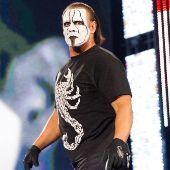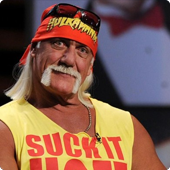The Man Called Sting – Wrestling Icon’s Final Match & Unforgettable Career

- Wrestling icon Sting’s last match arrives this weekend when he defends his AEW tag team title.
- Take a look back at Sting’s legendary wrestling career before this weekend’s big send-off.
- Sting’s time across numerous promotions and over decades is undeniably one for the books.
Most 62-year-olds don’t climb onto the safety rails of balconies, but Sting isn’t most 62-year-olds.
Placing one foot on the rail, he looks around at the 8,000 fans screaming at him mere inches away and leaps into the void. He flies nearly 20 feet through the air, crashing down and driving his opponent through four stacked folding tables.
Steve “Sting” Borden has enjoyed an illustrious career that spans five decades. Time waits for no one, as the saying goes, and the man called Sting is no exception. After 2,155 career matches, 26 championships in WCW, TNA, AEW, and the NWA, and a laundry list of accolades including inductions into the WWE, TNA, and Wrestling Observer Halls of Fame, among others, Sting is ready to call it a career.
Sting’s last match will see “The Icon” defend his AEW World Tag Team Championship (alongside partner Darby Allin) against The Young Bucks at AEW Revolution this coming Sunday, March 3rd. But how did Sting come to be one of the sport’s most endearing and popular wrestlers of all time?
About Sting (aka Steve Borden)

Born in Omaha, Nebraska, and raised in Southern California, Steve Borden played various sports growing up and even co-owned a Gold’s Gym at one point.
Borden, who was into bodybuilding, was asked by a WWE (then-WWF) scout if he’d be interested in joining a pro wrestling group, or “stable”.
After initially rejecting the offer, Borden was brought to a live WWE show and fell in love with the sport. He would soon enter the world of pro wrestling to begin training, forming a tag team with another future superstar in his own right: Jim “Ultimate Warrior” Hellwig.
After a few years of cutting his teeth in smaller promotions, Sting found himself in Jim Crocket Promotions, an NWA-affiliated organization that would soon be purchased by billionaire Ted Turner and rebranded as World Championship Wrestling (WCW).
Early WCW and Ric Flair Feud
Having impressed fans and WCW management alike with his athletic high-flying style, Sting was given a title shot at then-NWA World Heavyweight Champion Ric Flair at Clash of the Champions on March 27, 1988.
Flair vs. Sting was the main event of the card, and the match went to a 45-minute draw. Despite Sting’s relative lack of experience, the match was considered an instant classic. It even won the Wrestling Observer Newsletter’s Match of the Year award.
The two wrestlers would go on to feud on and off again for the next two-plus years, culminating with Sting finally besting Flair for the NWA World Heavyweight Championship at The Great American Bash in July of 1990.
Looking back at his own wrestling career, Flair at one point said that his fondest memories would be with Sting.
The NWO and “The Crow” Sting
For years, Sting was known for his bleach-blonde crew cut, vibrant spandex pants with colorful scorpion logos, and brightly colored face paint.
By 1996, however, his flat-top hair had grown long and dark, and the character slowly transitioned to a more black-and-white color scheme. His trademark colorful face paint also took on a more somber tone, as he began wearing white face paint with thin black lines running up and down, a look inspired by the cult underground movie “The Crow.”
Scott Hall and Kevin Nash played two extremely popular characters in then rival WWE — Razor Ramon and Diesel, respectively. After their WWE runs finished, they joined WCW as “The Outsiders,” a pair that would sit in the crowd wearing street clothes and regularly interfere with matches.
Eventually, they would bring Hulk Hogan into the fold and run roughshod all over the WCW, recruiting nearly the entire roster in the process.
Sting was the first WCW original to stand up to the NWO, and he would be their number-one rival over the next few years. His transition to “The Crow” era was cemented during this time, with Sting continually harassing NWO members by descending from the building’s rafters in a harness and attacking them with his signature black spray-painted baseball bat.
These angles were a significant driving force behind WCW beating WWE Monday Night Raw during the so-called “Monday Night Wars.”
Starrcade 97

WCW did a fantastic job of building up Sting vs. “Hollywood” Hulk Hogan — the de-facto leader of the NWO.
The back-and-forth between Sting and The NWO made fans rabid to see Sting take out the hated Hulk Hogan once and for all. Sting was continually offered the chance to fight other NWO members by then-commissioner J.J. Dillon, but these offers were rejected.
Sting wanted Hogan.
The match was booked for Starrcade 97 on December 28, 1997. However, it would become one of the most ridiculed contests in WCW history.
During the more than 18-month build, Sting was dealing with addiction issues, and spent large chunks of time recovering away from the ring. Partially because of this, he had “ring rust,” which is when wrestlers take extended periods off and lose physical and mental sharpness as a result.
WCW referee Nick Patrick was supposed to do a “fast count” on Sting during the match’s climactic finale, in which he would make the three count much quicker than how pinfalls are traditionally performed. When the time came, however, Patrick performed a standard three count at normal speed.
Rather than ringing the bell to signal the end of the match, special guest Bret Hart intervened and demanded the match continue, due to Patrick’s alleged fast count. Sting defeated Hogan when the match was restarted, but the convoluted finish left fans confused and unsatisfied.
Many experts point to this match as the moment the tide turned in the “Monday Night Wars,” as WCW Monday Nitro ratings soon began a steady decline that would eventually signal the death of the company as a whole.
End of WCW
By September 1999, WCW Nitro’s ratings were roughly half of the rival WWE Monday Night Raw.
After a series of ill-fated on-screen and backstage decisions failed to revive the company’s once-booming ratings (including a hard reset on all storylines and championships), WCW would be sold to the WWE.
The final episode of WCW Nitro aired on March 26, 2001, with Sting vs. long-time rival Ric Flair as the main event. Sting defeated Flair in the last match in WCW history, and the two embraced afterward in the middle of the ring.
This is noteworthy considering their history.
Ric Flair turns on Sting (again) to bring back The Horsemen 28 years ago yesterday at WCW Halloween Havoc (10/29/95) @OTD_in_WWE @Wrestling80s90s pic.twitter.com/rsnOrR0xaH
— No Context Flair (@NoContextFlair) October 29, 2023
While many (but not all) top-name wrestlers in WCW had their contracts picked up by WWE, Sting was one notable exception.
Sting had reservations about how former WCW talent were being treated by WWE on screen, and as a result, he chose not to sign with them. Even after WCW had gone under, Sting remained fiercely loyal to the company that made him a star.
After a few years working in the indies, Sting would once again resurface, this time in TNA.
TNA
Even though Sting was 44 years old when he first arrived at TNA in January 2006, he would once again become the face of WWE’s main rival promotion. Sting joining TNA brought legitimacy to the budding promotion, and helped it make its mark on the North American wrestling landscape.
He would engage in high-profile feuds with many former WCW and WWE stars, including Kurt Angle, Hulk Hogan, and Kevin Nash. Sting also feuded with rising TNA originals such as AJ Styles, Samoa Joe, and Abyss, helping elevate those wrestlers to main event-level status in the process.
Sting was the first person inducted into the TNA Hall of Fame in October 2012, and would finish his run with the company on January 23, 2014.
Throughout his tenure Sting remained one of the company’s most popular stars, continually reinventing himself while always staying true to himself and who he was. He would win the TNA Heavyweight Championship four times, and twice win “Match of the Year” at the TNA Year End Awards, among other accolades.
Sting in WWE
Sting’s long-awaited arrival in the WWE finally occurred on November 23, 2014, at Survivor Series. Oh, to be able to drop some wagers at the top WWE betting sites in those days.
What a time to be alive, indeed.
As HHH laid a beating down on Dolph Ziggler, Sting interrupted the attack and gave his patented Scorpion Death Drop finisher to HHH.
The HHH feud would culminate at WrestleMania 31 in a singles match that largely served as a tribute to the WCW vs. WWE war of the late 1990s and early 2000s. The match featured heavy interference from former NWO and D-Generation X members, with HHH gaining victory over Sting.
Rollins threw him into the corner with a routine Buckle Bomb (a powerbomb into the turnbuckle) and when Sting hit the turnbuckle, his head snapped back, instantly giving him whiplash. Sting has said this was a freak accident on several occasions and that Rollins was not at fault for the injury.
While this was his last match in WWE, it wasn’t his last appearance. Sting was inducted into the WWE Hall of Fame in April 2016. Sting also announced his retirement during his induction speech; however, like many wrestling retirements, it was short-lived. It would only be a few years before we saw Sting back in the ring.
Sting in AEW
On December 2, 2020, AEW’s Dustin and Cody Rhodes were being beaten down by members of Team Taz when the lights went out and a distorted guitar began playing. Snow fell from the ceiling as scenes of winter played on the video screens. After a moment of anticipation, Sting came out to make the save, sending Team Taz scrambling to exit the ring.
It’s worth noting that AEW aired on TNT at the time of Sting’s debut. WCW Nitro also aired on TNT —including the final WCW match pitting Sting against Ric Flair —and Sting’s AEW debut marked more than 19 years between appearances on the network.
The fact that Sting was soon paired with one of the company’s most popular acts in Darby Allin is a testament to his continued relevance in the wrestling industry.
Initially, Sting only signed up to perform in “cinematic” (pre-filmed) matches, which were common during the height of the pandemic, as fans weren’t allowed to physically attend shows. However, Allin convinced Sting to wrestle in front of live audiences once fans were allowed back; subsequently, Sting’s AEW run has featured some of the best work of his career.
It’s common for older wrestlers to heavily rely on their past fame during modern-day appearances, leaning on tired catchphrases and callbacks, and many of them have trouble physically wrestling as well. This is not the case with Sting. Despite being over 60 years old, Sting still holds his own in the ring.
On multiple occasions, Sting has dived off the top rope onto the floor outside, off of AEW’s entrance ramp, and even hurled himself off of second-story balconies; including leaping off a balcony guard rail and driving Andrade El Idolo through four tables some 20 feet below.
Time catches up with everybody, however, and on October 23, 2023, Sting announced that he would be retiring from in-ring competition. Sting and Darby Allin then captured the AEW World Tag Team Championships from “Absolute” Ricky Starks and Big Bill on February 7, 2024; Sting’s first championship title since his final TNA World Heavyweight Championship run some 12 years earlier.
Sting’s final match will see him and Darby Allin defend their AEW World Tag Championships against one of the best tag teams of all time (and AEW Executive Vice Presidents and co-founders), the Young Bucks, who first crossed paths with him a decade plus before in TNA.
Not only that, he’ll have his old on-again-off-again rival Ric Flair in his corner; a fitting tribute to Sting’s first major opponent and the man who helped put him on the map.
Sting’s Lasting Appeal
Sting has appealed to audiences the world over for nearly 40 years, and has constantly reinvented himself to stay relevant as many of his peers simply faded into being nostalgia acts. While many wrestlers from the 1980s–2000s suffer the ravages of time, Sting is still explosive and athletic, even in his early 60s.
Steve Borden enjoys near-universal praise for his pleasant backstage demeanor and willingness to work with anyone. One rarely hears negative comments about him from his fellow wrestlers. His graciousness is the stuff of legend, and there is no better example of his kindness than the disastrous Sting vs. Jeff Hardy match at TNA’s Victory Road 2011.
Sting was set to face Jeff Hardy for the TNA World Heavyweight Championship in a no-disqualification match on March 13, 2011. However, once Jeff Hardy made his entrance for the match it was clear he was intoxicated, and had no business being inside of a wrestling ring.
Jeff needed professional help. Rather than take liberties with Hardy and inflict real pain on him to teach him a lesson as many wrestlers might have, Sting patiently tried his best to work with Hardy for a few minutes. Once it became obvious Jeff Hardy was in no state to perform, Sting quickly pinned him and mercifully brought the match to an end.
Jeff Hardy is no stranger to substance issues, as the legendary wrestler has been open about his decades-long struggle with various addictions. A former addict himself, Sting has had nothing but good things to say about Jeff Hardy and his recovery in the time since the incident, a testament to Sting’s good nature.
Sting’s Wrestling Legacy
From his early feuds with Ric Flair, Hulk Hogan, and the NOW, to helping TNA make its mark, and becoming one of wrestling’s most respected elder statesmen, Sting’s legacy as one of the best and most successful wrestlers ever is indisputable.
He is widely considered to be the face of WCW, one of the most important promotions in North American wrestling history.
Nobody appeared in more WCW PPV matches than Sting, and he is tied with John Cena for the most ever PWI “Most Popular Wrestler of the Year” awards with four. He’s also wrestled on the WCW, TNA, and AEW pay-per-views with the highest buy rates in each company’s respective history.
Despite debuting nearly 40 years ago, Sting is as popular with young fans today as he ever was. Wrestling audiences are still peppered with fans wearing Sting masks, and t-shirt sales after his AEW debut broke the record for most shirts sold in 24 hours on the popular wrestling merchandise website ProWrestlingTees.com.
Sting has also appeared in approximately 30 wrestling games dating back to 1989 as well, and has over 200 individual toys and action figures released by WCW, TNA, WWE, and AEW.
A short list of his accolades include:
- 6x WCW World Heavyweight Champion
- 2x WCW United States Heavyweight Champion
- 3x WCW World Tag Team Champion
- 2x NWA World Heavyweight Champion
- NWA World Television Champion
- 4x TNA World Heavyweight Champion
- TNA World Tag Team Champion
- AEW World Tag Team Champion (current champion as of this writing)
- WWE Hall of Fame (2016)
- TNA Hall of Fame (Inaugural member)
- Wrestling Observer Newsletter Hall of Fame
- Professional Wrestling Hall of Fame
- 4x Pro Wrestling Illustrated “Most Popular Wrestler of the Year” (1991, 1992, 1994, 1997)
- #1 on the 1992 Pro Wrestling Illustrated PWI 500
The fact that legendary wrestlers Ric Flair and Hulk Hogan both had their final televised matches against Sting is also a testament to his popularity and importance in the business.
This Saturday, Sting will wrestle in his own final match, bringing to an end one of the most illustrious and storied careers the wrestling world has ever seen.
Love wrestling content like this? Check out the following post on the biggest WWE heels in history.
 75%
75% 80%
80%

